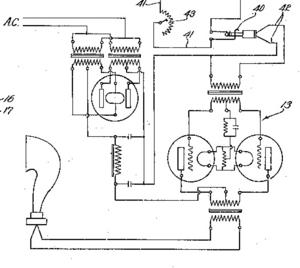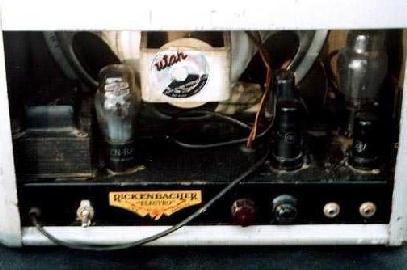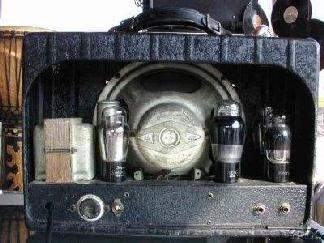 |

|

|

|

|

|

|

|
1930s - 1940s
And Beauchamp said "Let there be sound."
And there was sound, but first he had to describe how to produce it.
Consider this part of Beauchamp's famous 1932 patent drawing for the electric guitar (#2089171):

|
Granted, the amplifier shown here couldn't be very efficient. Two power triodes in push-pull, lacking any preamplifier of any kind, with only a coupling transformer between them and the transducer, would have been hard pressed to deliver one watt of power. An amplifier it was nevertheless, and it was dedicated to the guitar. And it even had a (now standard) jack!
The Speaker
...so was called the first practical guitar amplifier in catalogs. The wooden case pictured with the "frying pan" of the early years sported probably a more complete circuit. It is said to have been designed by C.W. Lane, one of Electro Strings stockholders, and built by the Van Nest radio shop in L.A. The case was provided by Johnson Cabinet Works, which made it out of plywood covered with Keratol. The very first models had no metal corners, nor did it feature the "Rickenbacher" logo. These came the following year.

|

|
In 1932, three versions were sold which could accomodate up to three instruments (respectively $62.50, $65 and $70).
The M series
This line of amplifiers predates the homonymous M-xx series built in the fifties. They appeared in the 1933 catalog.
M-11
Notice the fancy "Rick" speaker grid design and the linen-covered plywood. Five tubes : one rectifier, two for the preamp stage, and what appears to be two metal power tubes in push-pull, gave 12 Watts of power. Two instruments and a microphone could be plugged in but there was only one volume and one tone control. It costed $95 in 1933.

|
On this other variation, the speaker grid logo is pretty similar to the 1933 catalog M-11 and the number of tubes is the same. The control panel is not angled but located at the top of the case, and the lithography is different. Only two inputs, volume and tone controls. This item is post-1937 for sure: two 6V6s for the power stage, and the speaker number is 285717, reading Rola-19?7-17th week.

|

|

|
Hal Lindes, of Dire Straits fame, owner of the M-11 / Profession 12 above, writes:
"I have heard Leo Fender used to repair ric amps at his TV repair shop, which probably inspired and gave him the blueprint for his Fender amps."
Shock! Horror! Oh, the blasphemy! But quite possibly true... and:
"This is without question the best amp I've ever had the pleasure to play through. It utilizes a mixture of the Tweed Deluxe and the Tweed Bassman components which allow the pure tones of the guitar to sing in an uncolored and totally natural amplified state. I have never come across another amp like it."
M-12
Also in 1933, the "equivalent of 7 tubes"gave 15 Watts through a bass reflex 12" speaker for $115. Two volume controls on the angled panel probably allowed to mix between microphone and instrument inputs, hence the "Professional" adjective.

|
The combo featured above could belong to a later version of this amplifier: there are four pots, three of them surrounding a jack input. The one at far right should be the tone control. Speaker logo and panel graphics are different (same as chassis above), bare wooden case. The bakelite knobs seem more authentic than the ones on previously shown models.
M-10
Well, maybe. This thread on the Rickenbacker Forum describes a similar item with no light, one 10" Utah speaker, one 5V4, a metal 6N7 and two 6V6s (hence after 1936).

|

|
Hm... there are five tubes on picture above. Or is it a visual artefact? In any case, several electronic circuits might have been used in the same case. This is not unusual: Fender did exactly the same - even worse with solid-state and tube amps sharing the same reference.
So the amplifier pictured above could well be the model M-10, produced in fact by National. A question remains: why subcontract this equipment to National, which had migrated to Chicago in 1936, when Electro Strings, a California company which knew a bit about technology, could do it in-house?
The Black Metal Box
This 1937 all-metal killer is my favourite. Dressed in black, an elegantly menacing case threatens to deliver brutal power. Hawaiian music? No way! Its sleek, industrial design calls for something new... well... just twenty years in advance.

|

|
The "chickenhead" volume knob looks like a later addition here, replacing an input.

|
It was also sold as a set with a steel guitar, like the...
Model 59
Only professional musicians and well-off amateurs could obviously afford these amplifiers. Remember this was the 1930's Great Depression, when many were willing to work for one dollar a day. Not everybody could shell out a princely sum for an amplifier alone at that time, and Rickenbacker was quick to adapt with the Model 59 Hawaiian set, guitar and amplifier, for $59.50 in 1934. It was produced until 1946.
This model seems to have been extremely popular and is often seen today, usually with a lap steel. Like the "Black Metal Box", its overall design derives from the first "Speaker".

|
Several kind of amplifier cases were proposed in order to match the steel guitar, notably the lozenge-covered linen model with a round hole for the speaker seen in the catalogs, and the flat grid models, often with a "grey sunburst".

|

|
No, the decals aren't stock. The second picture offers a view of the amplifier's internals: simple electronics, point-to-point wiring. The small metal box is a more recent electrolytic capacitor - they usually last no more than twenty or thirty years, but here the others seem to have survived.
200A
Electro had hired Ralph Robertson to develop a new line of amplifiers. Several models were designed and built, such as the 15-watt 200A Professional Amplifier. A similar model with a smaller speaker can be seen on a picture of a 1941 trade show. The 200A was also used as a stand for the Vibrola guitar, the one whose embedded motor made it so heavy it couldn't stand on the player's leg. We don't know yet if R. Robertson participated in the design of the M Series. This thread gives a hint at the circuitry. Rectification was provided by a 5V4. A push-pull of 6L6 beam tetrodes was driven by a dual triode 6N7 - probably operating in parallel, as states its data sheet.
1948 Hawaiian Set
After the second world war, the company was back from making gyroscopes and other technical equipment for the military to music instruments. The Model 59 was replaced with this kind of student set:

|

|
The amp is metal bodied and would give about 5 watts of power with the following tubes: 6F6 (power pentode), 6X5GT (rectifier), 6N7 (driver) and 6SF5 (triode). It featured two inputs, and volume and tone controls.
Rickenbacker also sold student Hawaiian sets under the "Ace" and "American Academy" brands, probably in order to specialize the Rickenbacker brand in professional equipment.
See the Rickenbacker Web site for a nice presentation of Rickenbacker's early days, with a few pics of old Rick amplifiers.
This site is in no way associated with Rickenbacker International Corporation. Rickenbacker®, RIC, and logos are trademarks of Rickenbacker International Corp.